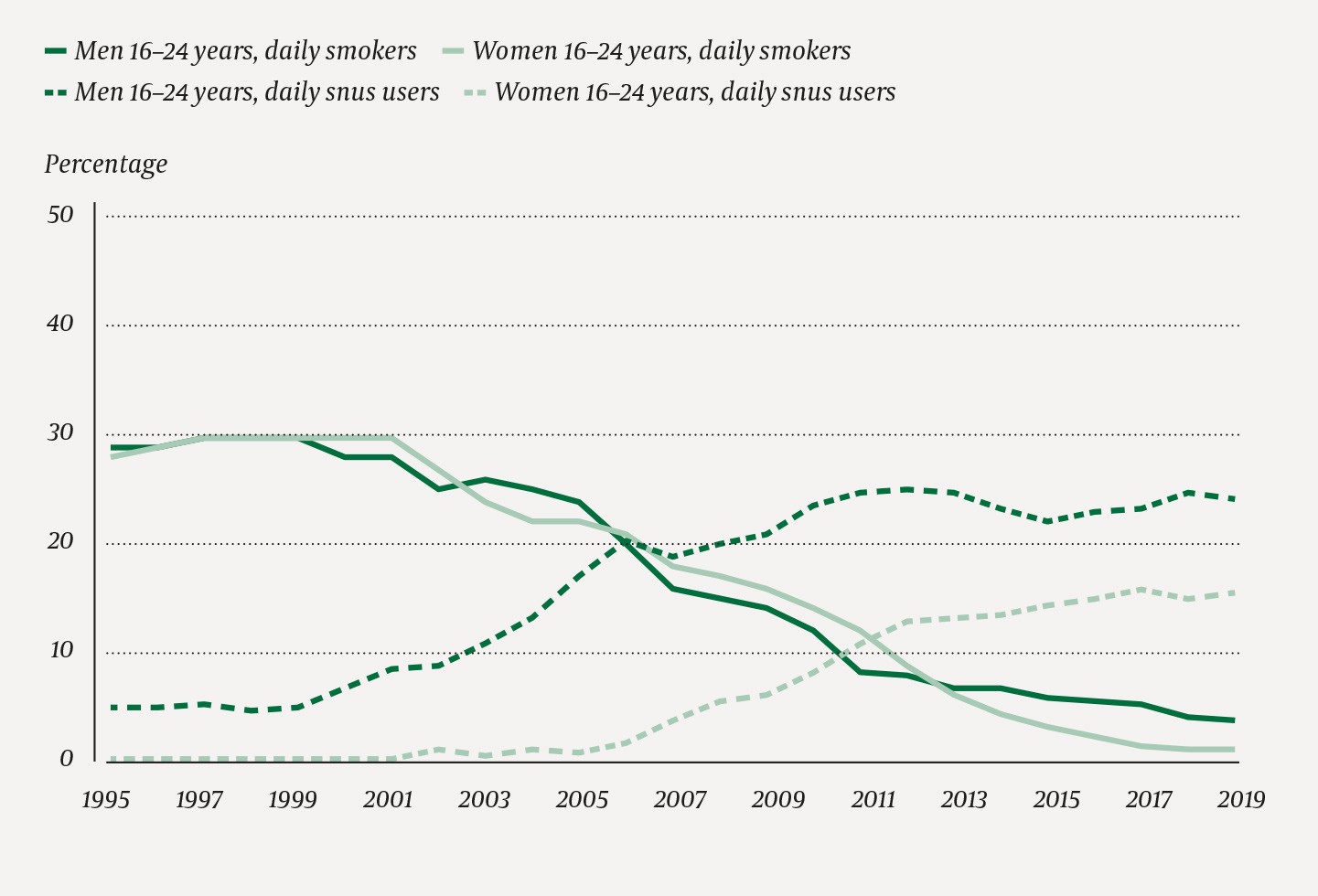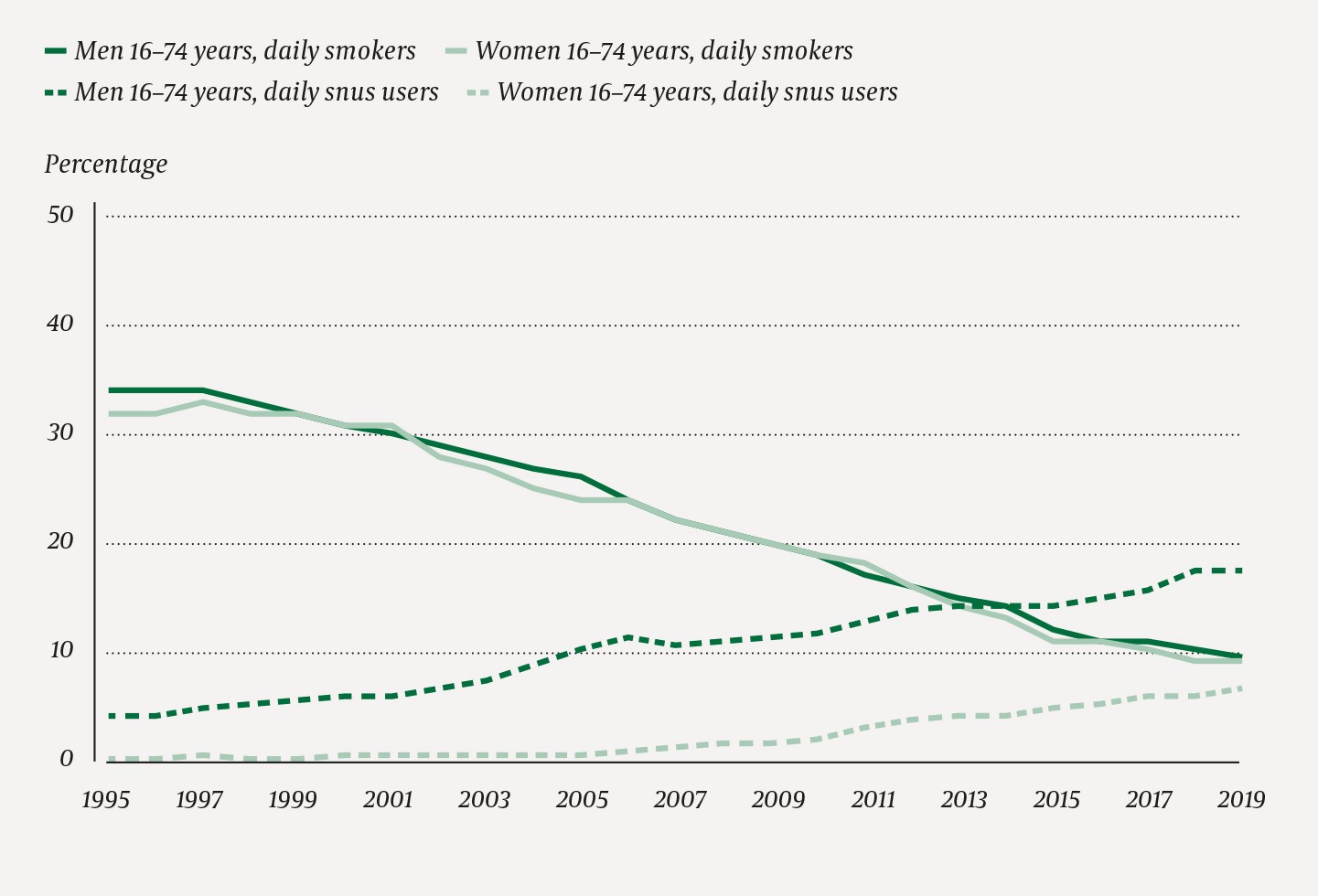There are plans to sell nicotine-containing e-cigarettes freely in Norway. In our view, the harmful effects of nicotine, particularly on young people and during pregnancy, should not be understated.
These new nicotine products can be very attractive to young people and women of childbearing age who might not otherwise have started using such products. E-cigarettes are regarded as being less harmful than cigarettes, and some researchers recommend them as a harm-reduction tool (1). People who need help to stop smoking can currently use oral moist snuff (snus) or nicotine replacement therapy (NRT) that can be purchased with or without a prescription. Do we then need more nicotine-containing products that may create new groups of nicotine users?
The ban on selling e-cigarettes containing nicotine was lifted by the Storting (the Norwegian Parliament) in 2016. Before the amending legislation can enter into force, a new set of regulations is expected to be put in place in 2021, stating requirements related to the content, quality, safety and labelling of such products in line with the EU Tobacco Products Directive. Nicotine-free e-cigarettes and nicotine-free ‘juice’ with different flavours are already on sale in specialist shops. The private import of nicotine-containing e-cigarettes for personal medical use is also permitted.
Nicotine dependence in young people
For many years, there has been a decline in cigarette smoking, even before snus became common. In Norway today, few adolescents take up the habit, and the increase in the use of snus also appears to be levelling off among young adults (Figure 1, Figure 2) (2, 3). In 2019, only 2–5 % of pupils in lower secondary school smoked or used snus. The use of snus was greater at upper secondary school level: 19 % among boys and 12 % among girls (4).

Figure 1 Percentage of men and women aged 16–24 years who smoked cigarettes and used snus on a daily basis in the period 1995–2019 (2, 3). Source: Statistics Norway/Norwegian Institute of Public Health.

Figure 2 The percentage of men and women aged 16–74 years who smoked cigarettes and used snus on a daily basis in the period 1995–2019 (2, 3). Source: Statistics Norway/Norwegian Institute of Public Health.
Permitting the sale of e-cigarettes may lead to increased use among adolescents and young adults, mirroring the increased use of snus that started among men from the turn of the millennium and later spread among women (Figure 1). From the turn of the millennium onwards, smoking declined for both men and women in parallel. While women largely seemed to have managed to stop smoking without turning to snus, men perhaps derived greater benefit from using snus in order to stop smoking. However, many of those who managed to stop smoking by means of snus, continued using it (5). At present, the use of e-cigarettes in Norway is relatively low – totalling approximately 3 % in the period 2016–19 for all ages and for both daily use and occasional use (6). Trying e-cigarettes is also common among adolescents who have never smoked before, and as a supplement to ordinary cigarettes (7). Young age is itself a risk factor for later nicotine dependence (8). Nicotine is a psychoactive and addictive substance, directly affecting the areas of the brain involved in emotions and cognitive processing (9). Therefore, developing a nicotine dependence at an early age can have a significant impact on adolescents. A cohort survey from the HUNT study showed that combined use of snus and smoking in early adolescence gave a prolonged high overall use of tobacco in adulthood (10). According to this study, the use of snus does not appear to have resulted in harm reduction. A clear disadvantage of using new nicotine products is that instead of quitting altogether, smoking or snus use may be replaced by another nicotine product. In addition, a systematic overview showed that e-cigarettes can result in more people taking up the habit of smoking tobacco (11).
Nicotine in pregnancy
It has been documented that the use of snus during pregnancy may cause physical harm (12), including to the development of the brain, heart and lungs of the fetus (13). If the sale of nicotine-containing e-cigarettes is permitted in Norway, this may contribute to new generations of nicotine users among women of reproductive age who might not otherwise have used tobacco.
Do we need more nicotine-containing products that can create new groups of nicotine users?
Relatively few pregnant women smoke during pregnancy, and there are few studies in Norway of their use of snus. A survey from south-eastern Norway showed that one out of four snus users continued to use snus throughout their entire pregnancy (14). In a report from the Norwegian Institute of Public Health, the risk entailed in using snus during pregnancy is given as estimated risk per 100 000 pregnant women who use snus compared with tobacco-free control groups (12). The report estimates that there will be 108 more stillbirths, 101 more extremely premature deliveries, 85 more oral cleft malformations and 2405 more caesarean sections per 100 000 pregnant women using snus. The impact on pregnancy outcomes is probably closely linked to the properties of nicotine, and will therefore be transferrable to other nicotine products. Recently, a large US population survey demonstrated that e-cigarettes represent an independent risk factor for neonatal complications, and that they are not a safe alternative to smoking tobacco during pregnancy (15).
Targeted approach to quitting smoking
Not only has the percentage of daily smokers been falling for many years, and very few young people start smoking nowadays, but use of snus among young adults is also levelling off. If both smoking and use of snus in Norway are slowly but surely dying out, why should we expose the entire population to new nicotine products such as e-cigarettes? We should not make a larger range of nicotine products more widely and easily available, but rather tailor these products to those who need them. As yet, we do not know how young people in Norway will react when nicotine-containing e-cigarettes can be purchased in shops.
The JUUL vaporiser has a high nicotine level as well as an attractive design that resembles a USB stick. It has become very popular among young people in the USA, where marketing has largely taken place through social media (16). The EU Tobacco Products Directive does not permit such a high nicotine level as in the USA. Nevertheless, allowing new nicotine products that appeal to young people in particular is not a positive step. Nicotine dependence and pressure to stop during pregnancy can be an additional burden for pregnant women. Moreover, it is an extra financial burden on young people in a life phase when many are hard up economically.
We should not make a larger range of nicotine products more widely and easily available, but rather tailor products to those who need them
E-cigarettes both with and without nicotine represent such a new phenomenon that the overall effect on public health is not yet clear. The Centers for Disease Control and Prevention in the United States recommend adopting a precautionary approach whereby vaporisers and similar products should not be used by young people or pregnant women, while adult non-smokers are advised to refrain from taking up the habit (17, p. 5). Norway is among the countries globally with the very lowest prevalence of smoking. Snus and nicotine-containing medicines are already on the market as aids to quitting smoking. E-cigarettes can also be useful for some people in this respect, but access to them should be limited to adult tobacco users.